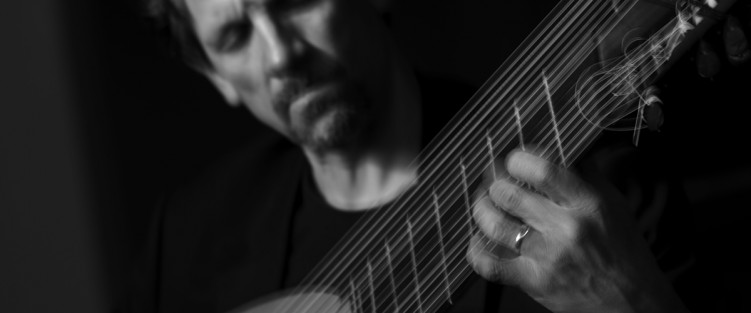 The specific concert that sparked this conversation takes place Sunday, November 19, 2017, in the Music at Metropolitan concert series at Metropolitan United Church, one of a cluster of major downtown religious edifices that gave Toronto’s Church Street its name. The Met United congregation will be celebrating its 200th anniversary in 2018. This particular concert celebrates music that goes back 200 years before that, but in an intriguingly modern way.
The specific concert that sparked this conversation takes place Sunday, November 19, 2017, in the Music at Metropolitan concert series at Metropolitan United Church, one of a cluster of major downtown religious edifices that gave Toronto’s Church Street its name. The Met United congregation will be celebrating its 200th anniversary in 2018. This particular concert celebrates music that goes back 200 years before that, but in an intriguingly modern way.
Titled “Jazz Standards of the Seventeenth Century,” it promises “ground basses, lute songs and madrigals sung and played with the freedom, invention and unpredictability of modern club performers” and is the brainchild of lutenist Ben Stein. Under the rubric “Musicians on the Edge,” it features Stein on lutes along with the Rezonance Baroque Ensemble (Rezan Onen-Lapointe, violin; and Dave Podgorski, harpsichord), along with co-conspirators Emily Klassen, soprano; Charles Davidson, tenor; and Erika Nielsen, cello.
A few days after our initial discussion, Stein got in touch, balking at the idea being characterized as his “brainchild.” “I hope what I’ve written doesn’t give the impression that this is a new thing I’ve come up with. If anything, I’m late to the program. There are a good number of [early music] groups building programs and ensembles around improv – but they are European for the most part. There are a few ensembles in the USA, and very little in Canada, which is why I’m pushing for it. And while places like the RCM are starting to add these elements, in my opinion they start too late. That was the key with the Neapolitans and their antecedents – it was built into early training. … Also we are being a bit liberal with the 17th century thing in the title; we`ve got a few bits of 18th- and 16th-century rep as well. It`s more about looking at the forms that musicians were aware of – ground basses, dances – that you can find in different centuries, though they evolved and changed during that time. …”
But let’s start at the beginning.
WN: So, how, why, when did you propose this idea to Pat Wright [Patricia Wright, music director at Met United]?
BS: Last year I presented a concert called “The Mystery of the Partimento” as part of the Music at Met series. It got a very good response from audience members who didn’t know quite what to expect, because no one knows what a partimento is. I didn’t until recently, even though I’d been playing early music for a number of years.
And what is it?
Essentially a bass line over which musicians were expected to extemporize melodies. Partimenti were a central element of Italian Baroque and galant music training, especially in the Neapolitan conservatories that produced some of the most popular performers and composers of that era. They resemble basso continuo accompaniment lines, but they weren’t just for chord harmonization. You were expected to use partimenti to create interesting melodies, and the Italians were renowned for their mastery of this skill.
Seeing how much people enjoyed having classical extemporization taking place before their eyes, I thought: if I was going to play a couple of rock or jazz sets for a club gig, I’d pick music I Iiked, find some musicians I was comfortable with and jam on the chord changes. Why can’t I do the same with classical repertoire I enjoy, playing melodic variations in a historically informed manner? So my colleagues and I are going to treat songs and madrigals, as well as partimenti and ground basses, as jumping-off points for improvisation, and no two renditions will be the same from rehearsal to concert.
Patricia Wright regularly programs early music at concerts and church services … The Rezonance Baroque Ensemble are actually Met’s artists-in-residence this year, playing at church services throughout the year, and also the featured ensemble for the Marg and Jim Norquay Celebration Concert in April 2018 – I’ll be joining them and other players for a collaboration/jam on Baroque concertos and sonatas. I’m planning to play the Vivaldi Lute Concerto in D, improvising on the the famous Adagio movement with the freedom of a player of the era.
I remember Jim Galloway, our long-time Jazz Notes columnist once remarking, in a column significantly on the topic of how to listen to jazz, saying (very loosely paraphrased), words to the effect of “If you want to find the structure and the beat listen to the bass, not the drums, It’s all built from that.” So when I saw this listing I immediately thought “Aha, the man with the lutes, especially the theorbo, must have had something central to do with this.” Is Renaissance/Baroque continuo as backline the way the word is used in a jazz context a far-fetched idea?
Jim was right! It really is “all about the bass.” Baroque and Renaissance musicians were aware at all times of the intervallic relationship between bass and treble voices. Beginner sight-singing exercises in the Neapolitan conservatories were not one-voice melodies, but two-voice duets, with the vocal line accompanied by a maestro or more experienced students. Musicians learned to improvise in melodic counterpoint to bass lines. They even had a name for musicians who possessed this skill: contrapuntisti. But contrapuntal knowledge is not fostered effectively in modern training; it’s reserved for advanced theory class, which is the worst place for it. So yes, I agree – if you truly want to understand a melody, play the bass line first! That should be de rigueur for all instrumentalists and singers.
“Freedom, invention, unpredictability.” These are the words chosen in the Music at Metropolitan release to try to capture the jazzy essence of the concert. But often in the jazz context the platform for those things working is the strong sense the players, and at best their audiences, have of the structures that allow for the apparent spontaneity of the “improvisations.” How far would you push the comparison in terms of the two musics structurally and in terms of the kinds of spontaneous on-the-spot negotiation that will take place among the players on stage during the performance? And would you say a jazz-lover in the audience might even have an edge over a typical period music aficionado, in terms of recognizing what is taking place?
Audiences of the Baroque court were aficionados, quite similar to the denizens of the jazz club. They were very aware of the components of composition – dance forms, ground basses, structural elements that recurred from composer to composer – and they expected invention and variation. I’ve found that classical audiences really enjoy hearing a model – a ground bass, madrigal or partimento – and then having a musician vary it before their eyes, composing on the fly. It’s as fun and engaging as watching a jazz musician take a solo, and rarer than it should be in early music performance, especially in North America.
So, problems of tuning aside, do you see the potential for an ensemble like yours, which is becoming comfortable with working from charts, actually rocking out with a jazz quartet capable of reading a Pergolesi oboe concerto score so you have a text to work with?
I am very interested in any kind of stylistic interaction that gets people challenging their preconceptions about how to play and sing - and most crucially, how to listen to music. I think classical musicians have a lot to learn from the jazz approach. And harmonically and structurally, there’s a lot more connection between rock, folk and early music repertoire than people understand or acknowledge. I’ve played Bach and 12-bar blues; Cole Porter and Caccini. I see more similarities than differences in them all. And I like to think of a score as something to be adventuresome with, to alter and vary, rather than to execute like a script within strict parameters. I’m advocating an approach that is serious, but not solemn; historically informed, but not historically constrained; and respectful, but not reverent towards the written score. If I feel like interrupting a composed set of variations to add my own, I’m going to do it – and encourage others to do the same.
So, all going well, what happen from here?
I’d simply like for the skill of improvisation to be more widespread among classically trained players. Why stop at the Baroque era? What if young musicians were given the tools and skills to improvise in a Classical or Romantic style? For that to happen, it’s got to be bred in the bone from the beginning of training, which means that our current approach has to be rethought. Even with various pedagogical attempts to develop creativity and stronger aural skills, we’re still very focused on correct execution of the written score as a primary goal, to the exclusion of all else. Score reading is a professional necessity, of course – but increasingly, so is improvisation. Baroque musicians could do both, and jazz musicians can do both, so it’s time for us to get with the program! The Neapolitans learned this approach from the very start of their training. Their beginner drills were simple, but the effect of them on young musicians’ ability to listen and create was profound.
This pushes your musical buttons, I see!
I’m a bit evangelical about pushing this, for sure, especially in Canada. It’s happening elsewhere, and has been for a while, but it’s not at all prevalent here. Very few people know about partimenti, and I’ve met players from all over the world who struggle to improvise Anyhow, ranting again! I could add that there’s a terrific website about partimenti, at Northwestern U which might entice people to have a look. Just google “Gjerdingen Partimenti” and you’ll find it. The guy who did it is one of the top two researchers in this area.
Better still, come on Sunday, November 19. Hopefully you’ll hear what I mean.
David Perlman can be reached at publisher@thewholenote.com.



